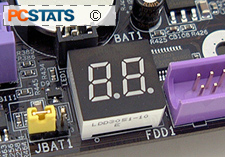 We were pleasantly surprised to see the how
well labelled the SL-K890Pro-939 was. For instance there is even a little
diagram just above the PCI Express x16 slot indicating which DIMM slots should
be used to enable dual channel memory. Excellent details there.
We were pleasantly surprised to see the how
well labelled the SL-K890Pro-939 was. For instance there is even a little
diagram just above the PCI Express x16 slot indicating which DIMM slots should
be used to enable dual channel memory. Excellent details there.
As far
as we can tell, Soltek has been equipping its higher-end motherboards
with Port 80 diagnostics cards over the last year or so, and that's great news for
enthusiasts and tweakers alike. Anyone who has used one will know how useful the
little two-digit display is. From memory issues to CPU or video problems, the Port 80 is
a real time saver when your system is malfunctioning!
|
A Brief History of USB
USB was developed in 1997 to replace the Serial/Parallel
I/O interfaces. The original USB 1.x standard allowed for speeds up to 12Mbps,
which is much faster than the 112Kbps Serial ports could provide.
While just fine for digital cameras, Scanners,
printers, keyboard/mice and joysticks, USB 1.x was much slower than
Apple's competing (and proprietary) IEEE 1394a ('firewire') standard and
could not be reasonably used with DV devices or high bandwidth external
devices like CD/DVD burners or hard drives. In April of 2000, the USB 2.0 standard was released. It supported speeds of up
to 480Mbps, but better yet, the new standard was also backwardly compatible with
USB 1.x.
USB's future is bright; today, pretty much any external device (high speed or not)
you can buy is USB compatible. Theres little doubt that USB is
the de-facto standard for connecting external peripherals to
computers. |
One thing
I've noticed, especially on Intel motherboards, is that many
manufacturers are almost completely dropping support for IDE devices. While it
is true that Serial ATA is succeeding IDE very quickly, there are still a
lot of IDE drives around and it's rather foolish to dump the old standard so
quickly.
To accommodate up to six IDE devices,
Soltek engineers have
integrated a Promise PDC20579 Serial ATA/IDE RAID controller onto the SL-K890Pro-939
motherboard. This is a clever move as the
Promise controller combines the best of both worlds: more Serial ATA ports for future
HDDs and plenty of IDE ports for current IDE drives.
It's
almost an
unwritten rule that as computers and components get faster,
they also run hotter. We're happy to report that VIA breaks this trend
with its K8T890 Northbridge. The heatsink that cools the Northbridge chip is no larger than
the ones found on the oldschool i440BX of yesteryear! Let it be known that
the VIA K8T890 is not a furnace like the 915/925XE (or even the ICH6) or
nForce3/4 chipsets.

About the only
thing I found to complain about with the SL-K890Pro-939 is
the location of the floppy drive connector (my personal pet peeve). Blah blah
blah, I'm sure you've heard it before but in its location at the bottom of
the motherboard, it makes connecting the floppy a lot more difficult for those who
use larger cases.
